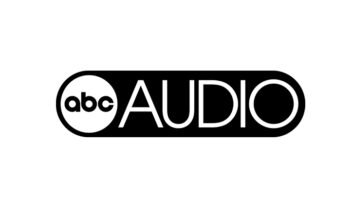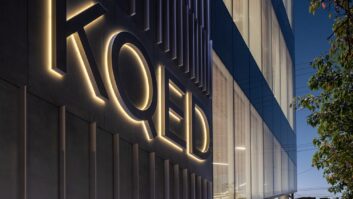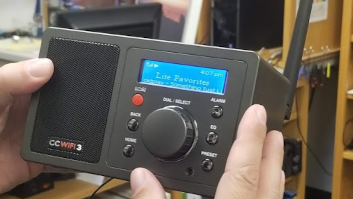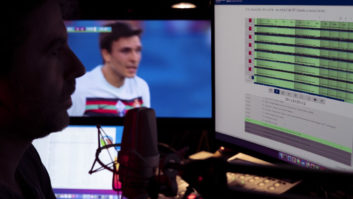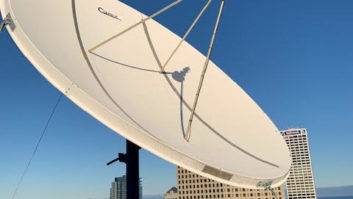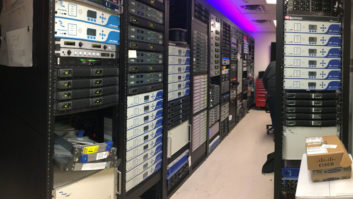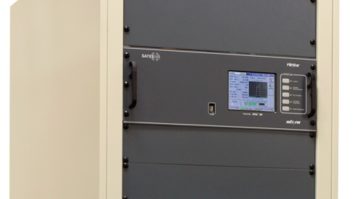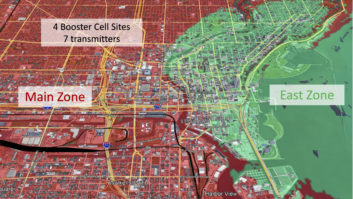Planned Transition
Nov 1, 2007 12:00 PM, By Chriss Scherer, editor
� The air studios have identical layouts. This is WJJK’s studio.


Each guest has his own mic and headphone control turret.

The secondary countertop is contoured to match the original counter.

The secondary countertop is contoured to match the original counter.

The console can be expanded with another fader module if needed.

Show hosts, producers and production staff have desks in front of the studios

A channel was made under the counter lips to accommodate the LED rope lighting.

When a station plans to rebuild its studio facilities, the idea typically involves a complete overhaul. With a few exceptions, all the equipment is updated. The sweeping upgrade also provides a clean slate for the facility. A new wiring plan can be developed and equipment can be housed in the most logical position rather than the only available position. While this approach is usually the most desired, it’s not always the most practical.
There could be reasons for only upgrading part of a facility, and quite often those reasons are budgetary in nature. This is a legitimate approach. While a total studio move has its own difficulties, an in-place upgrade is trickier because the station has to be able to stay on the air during the transition. The engineer can spend a great deal of his time ensuring minimal interruption to the on-air signal, not to mention the extra efforts needed to minimize the interruption and inconvenience to the air staff.
This Facility Showcase brings us to the studios of the Cumulus stations in Indianapolis. This facility upgrade was primarily centered on the on-air consoles.
In the beginning
The studio facility was actually constructed in 1998. The facility was designed to house the three stations Susquehanna owned. Today, those stations are WFMS-FM (country), WJJK-FM (Jack) and WWFT-FM (FM talk). When it was completed, the three air studios, back-up air studio and production rooms included the most appropriate technology for the function. The air studios were built around a newly designed digital on-air console. The production studios had new digital production consoles. The backup air studio was built around an analog audio console that is still going strong today.
All the consoles were stand-alone designs, which was the leading technology in 1998. Unfortunately, the chosen digital consoles did not perform as well as they were expected to perform. Intermittent failures and susceptibility to static discharges were the common problems. The stations tried to remedy the problems, but they could not eliminate the difficulties and ended up working with and around the problems.
Eventually, enough is enough. After eight years of heroics to keep the digital consoles running, the decision was made to replace the consoles. By 2006, console technology had advanced. Router-based designs had proven to be reliable. The studios themselves were still in overall good working order, so completely starting over didn’t make sense either. The Cumulus stations didn’t need a new audio infrastructure, just the consoles. A compromise was made that would allow the stations to be ready for future upgrades without creating an undue burden to the current operation. This upgrade would begin the path for the stations to gradually move into a networked audio infrastructure.
All four control rooms have identical layouts, which simplified the planning for the air studios. The changes to one could be applied to the other two.
Two routers
The stations already used an SAS 64000 for audio routing. Because the other studios would retain their existing stand-alone consoles, the SAS router needed to remain in place. The Wheatstone Bridge is also a router, but instead of replacing the SAS, the two routers were installed to work side-by-side. The Wheatstone Bridge router is used as the I/O for the Generation 6 surfaces, while the SAS 64000 is still used for primary source switching. Each air studio also has a Bridge Satellite cage to accommodate local sources in each studio.
Using the Bridge to multiplex the signals to and from the technical operations center has also eliminated another potential problem: insufficient cable pairs between the studio and TOC. Now that signals are multiplexed, there are plenty of signal pairs available.
The transition to the new console surfaces was simplified because the three stations have a back-up air studio. This studio is often used for voice tracking and interviews, but it served its purpose well during the upgrade as each station was upgraded.
But there was another obstacle to overcome before the new console surfaces could be installed. The original air studio furniture was built by Studio Technology. The opening in the countertop fit the previous consoles just fine, but the new consoles were a problem because they have guest turrets, which meant further modifications to the countertop.
The solution was to build a new countertop, not replace the existing countertop, which was structurally part of the furniture. The top is also part of the wire mounting system in the room. One idea was to add a square platform to cover the old hole and provide support for the new surface. But this would have an odd look and draw attention to the modification.
The solution was to design a new top three inches smaller than the original. The new top was placed over the old one to create a stepped effect. This covered all the previous holes and marks. The result looks designed instead of being an obvious add-on. It solved the problem without a significant demolition and rebuilding of the room.
This project eliminated an ongoing problem for the three stations, but also set the stage for a future upgrade path. This same approach can easily be applied to other stations wanting to upgrade without making a complete change all at one time. The Cumulus Indianapolis facility has plans to upgrade two more analog consoles in the same way. These aren’t part of a formal schedule yet.
Equipment List
Audiometrics CD-10
Audion Labs Vox Pro
Beta Brite sign
Comrex Matrix, Vector
Cybex Autoboot Commander 4XP
Denon DN-951FA, DN-C550CR
Elo touch monitors
Enco DAD
Ergotron monitor stands
ESE Clocks
E-V RE-20, RE-27 ND, Eventide BD600
Harris World Feed Panel Henry Matchbox II, Superelay
JBL 4408, QSC MX700
Rode Broadcaster, NT2
SAS 32000, 64000
Sennheiser MKE4032
Sine Systems MBC-1.5
Sony MDS-E12, PCM R-500
Studio Technology Furniture
Symetrix 528E
Telos One, 1A2 Interface, Zephyr, Zephyr stream
TFT 911
Wheatstone Bridge, Generation 6





